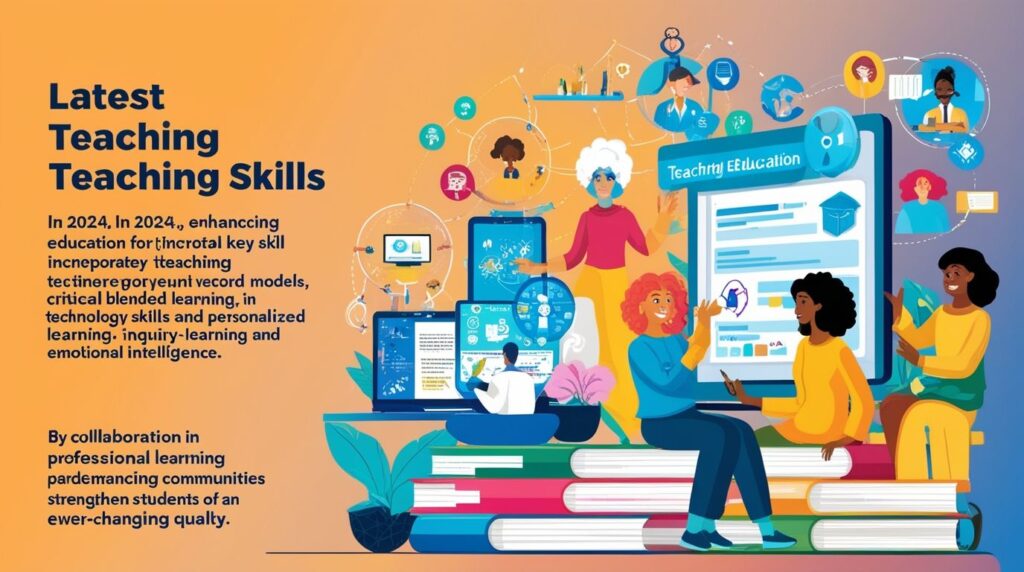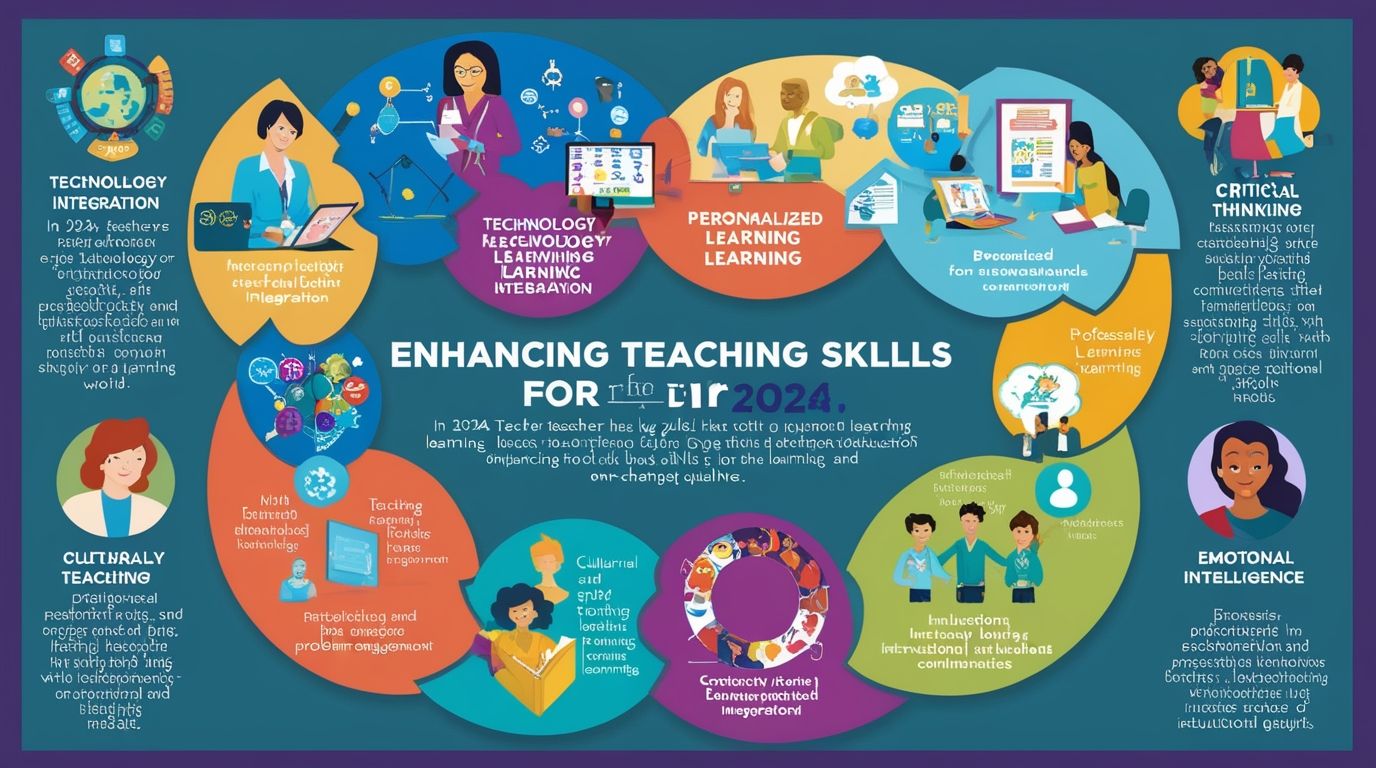Latest Teaching Skills Enhancing Education for the Future,Teaching is evolving rapidly as educators face a world transformed by technology, societal shifts, and new educational needs. In 2024, teachers are required to adopt and master a fresh set of skills to effectively engage students and prepare them for the future. This article explores the latest teaching skills that are shaping modern classrooms, emphasizing technology integration, student-centered approaches, inclusive teaching practices, emotional intelligence, and the fostering of critical thinking.
1. Technology Integration and Digital Fluency
In today’s education landscape, technology plays a pivotal role. Teachers need to be proficient in using various digital tools, platforms, and learning management systems (LMS) to enhance the learning experience. The COVID-19 pandemic has accelerated the adoption of technology in education, making digital fluency an essential skill for teachers.
Key Aspects of Technology Integration:
- Blended Learning: This approach combines online and face-to-face instruction. Teachers should be adept at integrating both formats seamlessly, creating an interactive and engaging hybrid learning environment.
- Educational Technology Tools: Proficiency in using tools like Google Classroom, Microsoft Teams, Zoom, and interactive whiteboards is essential. Teachers must also be skilled in multimedia creation (e.g., video lectures, podcasts) and the use of AI-powered tools like ChatGPT for personalized learning.
- Data Literacy: Teachers need to analyze student performance data to tailor their instructional strategies. Using analytics from online platforms can help educators identify struggling students, adjust lesson plans, and provide timely interventions.
By mastering these tools, teachers can enhance learning outcomes, streamline their work, and engage students in ways that traditional methods cannot achieve.
2. Student-Centered and Personalized Learning
Traditional, teacher-led approaches are being replaced by student-centered learning, where students take an active role in their education. Personalized learning focuses on adapting instruction to meet the diverse needs, interests, and abilities of individual students.
Core Elements of Student-Centered Learning:
- Differentiated Instruction: Teachers need to adjust their methods to accommodate diverse learning styles. This could mean offering various pathways for students to demonstrate mastery, such as through projects, presentations, or digital portfolios.
- Inquiry-Based Learning: Encouraging students to ask questions, investigate, and engage in problem-solving develops critical thinking. Teachers must facilitate inquiry-based projects where students take the lead in their learning.
- Flipped Classroom: In a flipped classroom model, students learn new content at home (via online resources), and class time is used for deeper engagement through discussions, problem-solving, and group work. Teachers must be proficient in curating online materials and fostering active learning in class.
By focusing on the student as the central figure in the learning process, teachers empower students to take ownership of their education, fostering autonomy and intrinsic motivation.
3. Inclusive and Culturally Responsive Teaching
Classrooms in 2024 are more diverse than ever, requiring teachers to be culturally responsive and inclusive. This means being aware of and sensitive to the different cultural, social, and economic backgrounds of students. Inclusive education also extends to students with disabilities and those with different learning abilities.
Best Practices in Inclusive Teaching:
- Culturally Responsive Pedagogy: Teachers must incorporate students’ cultural references into the learning process. This involves recognizing and addressing cultural biases and creating a curriculum that is reflective of the diverse student population.
- Universal Design for Learning (UDL): UDL principles promote flexible learning environments that can accommodate individual learning differences. Teachers should design their lessons with multiple means of engagement, representation, and expression to cater to all learners.
- Social-Emotional Learning (SEL): SEL programs help students develop empathy, resilience, and communication skills. Teachers must incorporate SEL into their daily routines, fostering a supportive and emotionally safe classroom environment.
Inclusive education ensures that every student feels valued and is given the tools they need to succeed, regardless of their background or learning abilities.

4. Emotional Intelligence and Well-being
Emotional intelligence (EQ) is increasingly recognized as a crucial skill for teachers. EQ involves the ability to understand and manage one’s own emotions, as well as the emotions of others. In a classroom setting, a teacher’s emotional intelligence can significantly impact the learning environment.
Aspects of Emotional Intelligence in Teaching:
- Self-awareness and Regulation: Teachers need to be conscious of their emotional state and how it influences their interactions with students. Remaining calm and collected, especially in stressful situations, helps maintain a positive classroom climate.
- Empathy: Understanding and being sensitive to the emotional needs of students can build trust and a supportive learning environment. Empathetic teachers are better equipped to handle conflicts, provide emotional support, and foster a sense of community in the classroom.
- Stress Management: Teaching can be stressful, and managing stress effectively is crucial for both teachers and students. Teachers need to model and teach coping strategies, mindfulness, and stress-reduction techniques to promote mental well-being.
Teachers with high emotional intelligence can create classrooms where students feel emotionally safe and supported, which is key for fostering learning and growth.
5. Critical Thinking and Problem-Solving
In 2024, preparing students for the future means equipping them with skills that extend beyond memorization and basic knowledge acquisition. Critical thinking, problem-solving, and creativity are crucial for success in an increasingly complex world.
Fostering Critical Thinking in the Classroom:
- Socratic Questioning: Teachers should employ questioning techniques that challenge students to think deeply and justify their reasoning. This helps students develop analytical skills and learn how to construct well-supported arguments.
- Project-Based Learning (PBL): PBL encourages students to engage in real-world problems, fostering critical thinking, collaboration, and communication skills. Teachers must design meaningful projects that require students to research, plan, and execute solutions.
- Collaborative Learning: Group work and collaborative projects encourage students to share ideas, debate, and solve problems together. Teachers must guide students in working together effectively and resolving conflicts that arise during collaboration.
By encouraging critical thinking, teachers help students develop the ability to analyze information, question assumptions, and come up with innovative solutions to challenges.
6. Adaptive Teaching and Flexibility
The ability to adapt to changing circumstances is essential for teachers in 2024. Whether due to technological advancements, shifts in curriculum standards, or societal challenges, teachers must be flexible and willing to adjust their teaching methods.
Key Aspects of Adaptive Teaching:
- Growth Mindset: Teachers with a growth mindset believe that their skills and knowledge can always improve. This mindset encourages continuous learning and openness to new teaching strategies.
- Reflective Practice: Regular reflection on one’s teaching practices helps educators identify areas for improvement and adapt to the needs of their students. Teachers should engage in self-assessment, peer observations, and feedback from students to refine their methods.
- Resilience and Adaptability: The ability to navigate unexpected challenges, such as shifts to online learning or accommodating diverse learner needs, is critical. Teachers should embrace change and view challenges as opportunities for growth.
Flexibility in teaching ensures that educators remain responsive to the dynamic nature of education and continue to provide relevant, engaging instruction.
7. Collaboration and Professional Learning Communities (PLCs)
Collaboration among teachers is a growing trend in modern education. Professional learning communities (PLCs) offer a space for teachers to share best practices, troubleshoot challenges, and support each other’s growth.
Components of Effective Collaboration:
- Peer Coaching: Teachers work together to observe each other’s classrooms, provide feedback, and collaborate on lesson planning. This reciprocal relationship helps both parties improve their teaching.
- Shared Resources and Expertise: Teachers should engage in sharing resources, lesson plans, and instructional strategies through both in-person and online platforms. This collective knowledge improves instructional quality and ensures that students benefit from the best teaching practices.
- Ongoing Professional Development: Teachers need to participate in continuous professional development (CPD) to stay updated on the latest teaching methodologies, tools, and research. PLCs can serve as a support system for teachers to implement new strategies learned in CPD sessions.
Collaboration fosters a community of lifelong learners among teachers, which ultimately benefits students.
Conclusion
The teaching profession in 2024 requires a diverse set of skills that go beyond traditional methods of instruction. Teachers must be tech-savvy, flexible, and emotionally intelligent, while also fostering student-centered, inclusive, and collaborative learning environments. By integrating these skills into their practice, teachers can better prepare students to navigate a rapidly changing world. Through ongoing professional development and the use of innovative teaching strategies, educators can continue to improve and inspire the next generation of learners.
References:
- Darling-Hammond, L., & Hyler, M. E. (2020). Preparing Teachers for a Changing World: What Teachers Should Learn and Be Able to Do. Jossey-Bass.
- Fullan, M., & Langworthy, M. (2014). A Rich Seam: How New Pedagogies Find Deep Learning. Pearson.
- Fadel, C., Bialik, M., & Trilling, B. (2015). Four-Dimensional Education: The Competencies Learners Need to Succeed. Center for Curriculum Redesign.
- Sheninger, E. (2021). Digital Leadership: Changing Paradigms for Changing Times. Corwin Press.

3 thoughts on “Latest Teaching Skills Enhancing Education for the Future”
Comments are closed.